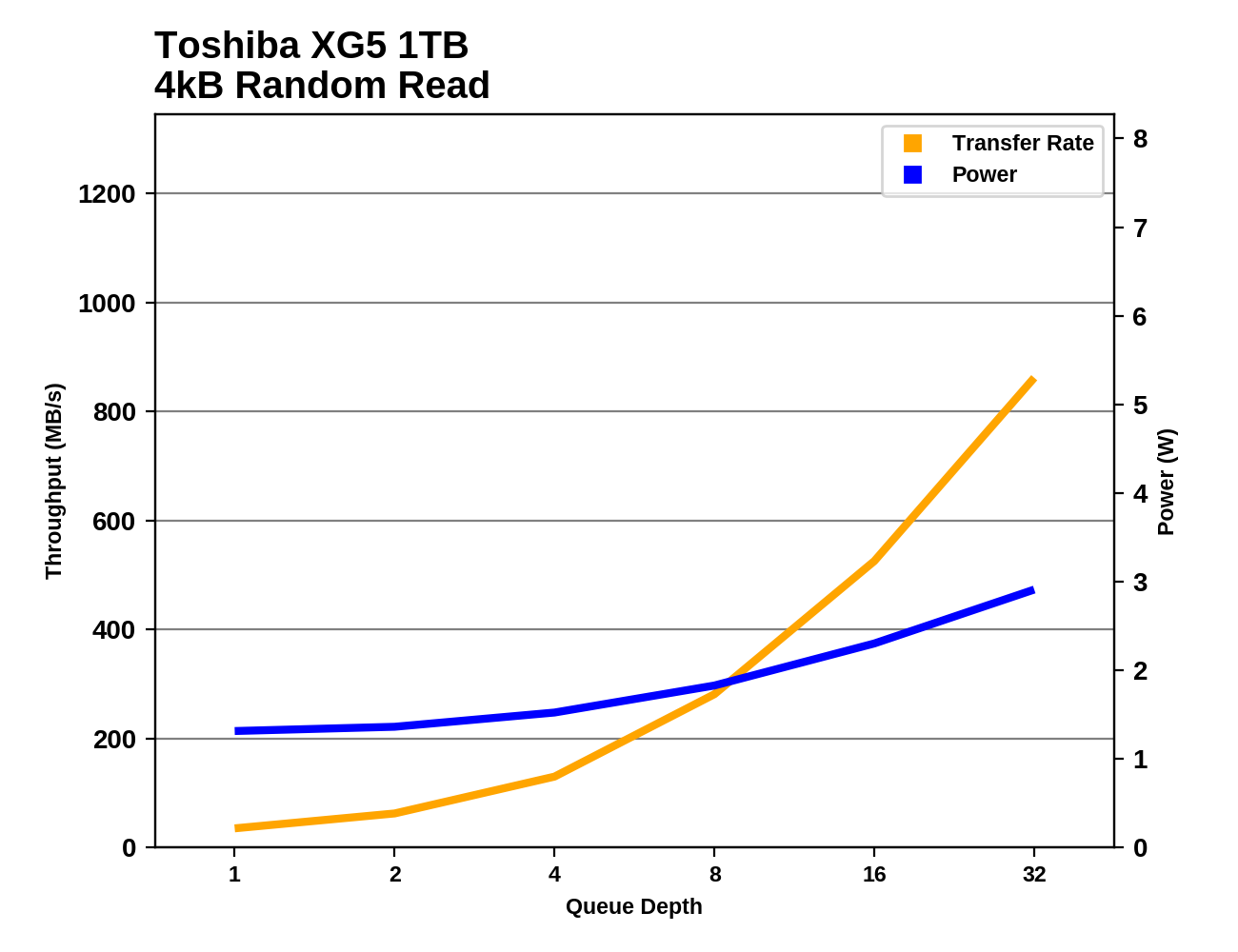The Toshiba XG5 (1TB) SSD Review
by Billy Tallis on August 3, 2017 9:01 AM ESTRandom Read Performance
Our first test of random read performance uses very short bursts of operations issued one at a time with no queuing. The drives are given enough idle time between bursts to yield an overall duty cycle of 20%, so thermal throttling is impossible. Each burst consists of a total of 32MB of 4kB random reads, from a 16GB span of the disk. The total data read is 1GB.

The Toshiba XG5 is tied for the position of fastest TLC SSD, sharing that position with the WD Black. The Samsung 960 EVO is about 11% slower, and all of the MLC drives are faster—over 50% faster in the case of Samsung's 960 PRO.
Our sustained random read performance is similar to the random read test from our 2015 test suite: queue depths from 1 to 32 are tested, and the average performance and power efficiency across QD1, QD2 and QD4 are reported as the primary scores. Each queue depth is tested for one minute or 32GB of data transferred, whichever is shorter. After each queue depth is tested, the drive is given up to one minute to cool off so that the higher queue depths are unlikely to be affected by accumulated heat build-up. The individual read operations are again 4kB, and cover a 64GB span of the drive.

When slightly higher queue depths and longer run times come into the picture, the XG5's random read performance looks worse. The XG5 ends up second from last place among PCIe SSDs, with both the WD Black and the Samsung 960 EVO leaping ahead of the XG5.

In spite of relatively poor random read performance, the XG5 continues to deliver great power efficiency that is clearly better than any previous TLC PCIe SSD, including the 960 EVO.
 |
|||||||||
At every queue depth of the sustained random read test, the Toshiba XG5 uses less power than any competing NVMe SSDs, and it's the only one in this batch to stay under 3W for the whole test. Most of those competitors can ramp up performance faster as the queue depth increases, but the XG5's scaling difficulties aren't very serious.
Random Write Performance
Our test of random write burst performance is structured similarly to the random read burst test, but each burst is only 4MB and the total test length is 128MB. The 4kB random write operations are distributed over a 16GB span of the drive, and the operations are issued one at a time with no queuing.

The Toshiba XG5's QD1 random write performance is about average for NVMe SSDs; only the Intel SSD 750 with its enterprise heritage is a significant outlier.
As with the sustained random read test, our sustained 4kB random write test runs for up to one minute or 32GB per queue depth, covering a 64GB span of the drive and giving the drive up to 1 minute of idle time between queue depths to allow for write caches to be flushed and for the drive to cool down.

The Toshiba XG5's sustained random write performance is far lower than the Samsung 960s or the Intel 750, but the XG5 is still about average for a NVMe SSD even when MLC SSDs are included. The Intel 600p and WD Black offer barely half the random write throughput of the XG5.

The XG5's power efficiency is a close second behind the Samsung 960 PRO, and clearly ahead of the 960 EVO. The XG5's efficiency is three times higher than the TLC-based Intel 600p or WD Black.
 |
|||||||||
The Toshiba XG5's random write performance flattens out at QD8, which is around where most of the high-performing drives saturate. Unfortunately, the performance of the XG5 when it reaches its limit is nothing remarkable. The XG5's power consumption does remain by far the lowest even across the entire test, though its efficiency is not always superior to the Samsung 960 PRO.










28 Comments
View All Comments
Billy Tallis - Monday, August 7, 2017 - link
We always try to get as many different capacities as possible. Some vendors are more willing than others to sample one of each size. Lately with the flash shortage, most vendors have been hesitant to send the full range of samples, and even after the product launches their PR teams have pretty limited sample availability.When I'm reviewing a single drive, I try to include primarily other drives from the same capacity class. If you want to compare eg. a 250 GB NVMe drive against a 512GB SATA drive, that's what our Bench database is for. (Though I haven't posted the 2017 results to Bench yet, and won't have time for that until after Flash Memory Summit.)
Bullwinkle J Moose - Thursday, August 3, 2017 - link
NewEgg insiders could buy the Samsung 850 Pro this week for $109 (256GB)A 10 year warranty on the Worlds Fastest consumer SATA drive turned out to be less expensive than a slower TLC drive with 3 - 5 year warranty then adding an extended warranty
Or you could just save $10 and get a slower TLC drive with a crappy warranty
Your choice
Kwarkon - Saturday, August 12, 2017 - link
Hi, you state that you have L1.2 enabled in your Idle powertest but clearly it is not working on your setup.I guess you use PCIe vertical to m.2 adapter and because of that you cannot go lower than L1.
SanX - Monday, August 14, 2017 - link
A year later and still 3x slower then Samsung 960 ? Why this company still exists?